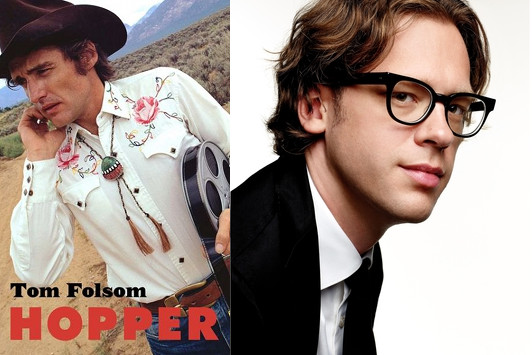Tom Folsom’s Odyssey in Hopperland

photo via TomFolsom.com
Hopper: A Journey into the American Dream is a new biography of actor/director Dennis Hopper by Tom Folsom, who I’d previously known for The Mad Ones, a book about New York organized crime figure Joe Gallo. So that’s an interesting mix for a young author, right there… As the author of a 1970s Hollywood retrospective, I’m going to be very interested in learning what Tom was able to uncover about The Last Movie, which notoriously derailed Hopper’s directing career for nearly a decade—but which has since been re-assessed by many as an artistic triumph, although it’s hard for the rest of us to judge since it’s still not available on DVD. Maybe this book can light a fire under that process…
It’s a dangerous headspace to be in, Dennis Hopper’s, where I’ve been for the past three years, writing my unconventional biography on the legend, icon, actor, director, and Hollywood outlaw. Now that I’m back from the front lines of HopperLand (and thankful I didn’t have to check into rehab), I’ve got a road-weary traveler’s bent to discuss my travails through his world. Perhaps I should nail up a sign: Abandon all hope, ye who enter here.
Unfortunately, I never got to met the man as planned because Hopper passed away in May 2010, just months after I began the book—but my first steps into his story made it clear we’re talking about someone who, as his buddy Kris Kristofferson put it in his song about Dennis, was: “a walkin’ contradiction, partly truth, partly fiction.”
This motto would make a traditional biographer scream. (Or perhaps sit in the middle of a ring of dynamite and light the fuse, as Hopper did as a stunt in the 1980s.) Luckily, I never intended to spend three years churning out cotton candy for the mill, or write a typical Hollywood biography. I set out to capture the distinct literary quality of someone who lived his life like a modern day Don Quixote, always pushing the edges of his outer envelope, in search of his peculiar American Dream.
This biography wasn’t stamped “authorized”—in fact, I never bothered to ask anyone’s permission. I hit the road Easy Rider style (albeit in a rental car) in search of Hopper tales. I tracked down those in his inner circle, including a handful of his five wives, had an epic sit-down with Peter Fonda over tequila at the Beverly Wilshire, visited the studios of Hopper’s art buddies in Venice, and found (after an exhaustive search) the whereabouts of enigmatic actress Linda Manz, then the teenage star of Hopper’s nihilist cult film Out of the Blue
Along the way, I visited Dodge City, Kansas, where Hopper spent his Dust Bowl childhood. I stopped in Taos, New Mexico, site of Hopper’s “lost years” in his drug-addled, cocaine-fueled 1970s, where he lived in a sprawling adobe mansion that was, while he lived there, supposedly haunted by a female ghost, and once the stomping ground of D.H. Lawrence. I lived in Taos for three months, digging under dusty rocks to uncover the truth behind the tales of Hopper’s wild days. Finally, it was back to civilization in New York City, where I spent weeks at the library doing tons of hard-core historical research.
Getting all of the crazy tales in my pocket ended up being the easy part. The challenge of writing about Dennis Hopper was trying to figure out why the hell he put himself through what should have killed him at the end of every chapter. Was he in fact trying to accomplish something artistically, spiritually, out there in the high desert of Taos, with the stockpile of guns and film canisters, the tequila and cocaine?
Slowly it became clear I was onto a story greater than the man, the unfolding of an American epic about a boy from Dodge City, Kansas who loved the singing cowboy pictures so much, he wanted to live onscreen, shooting it out, starring in the wild Western of his life. A little boy version of The Wizard of Oz and the twister spirits him away.
5 March 2013 | guest authors |

 Our Endless and Proper Work is my new book with Belt Publishing about starting (and sticking to) a productive writing practice.
Our Endless and Proper Work is my new book with Belt Publishing about starting (and sticking to) a productive writing practice. 
